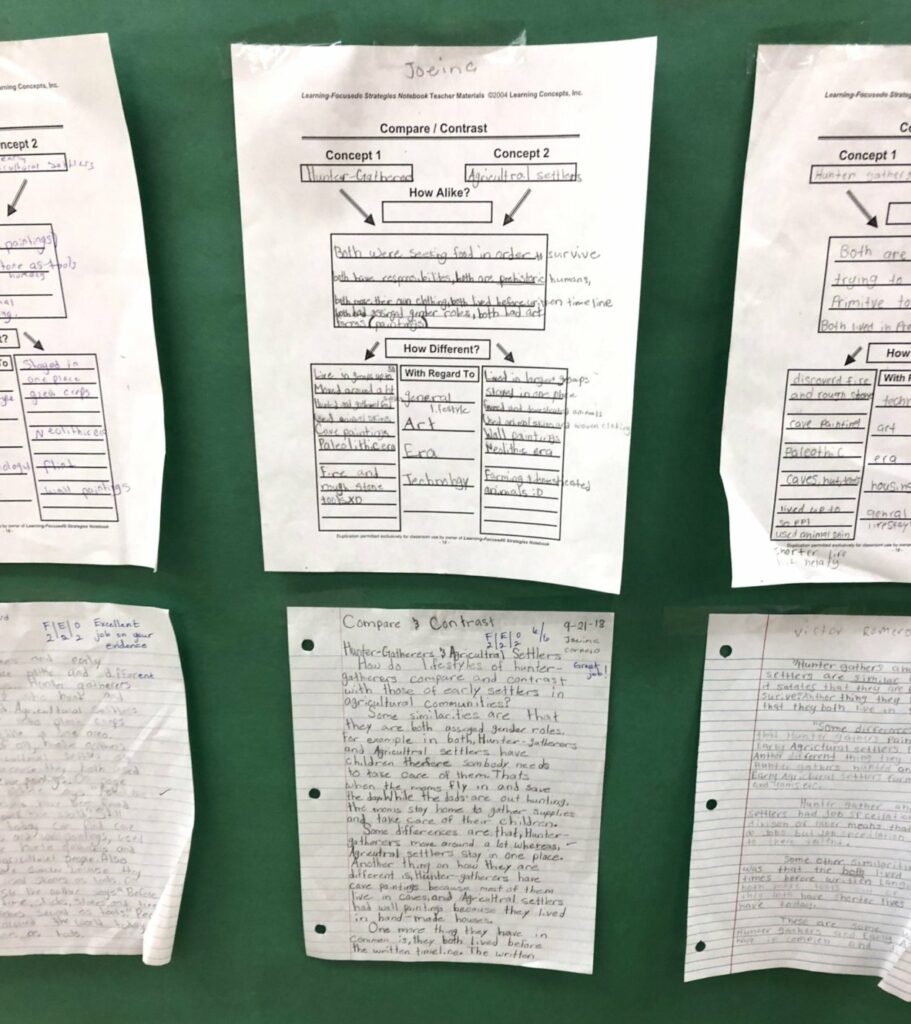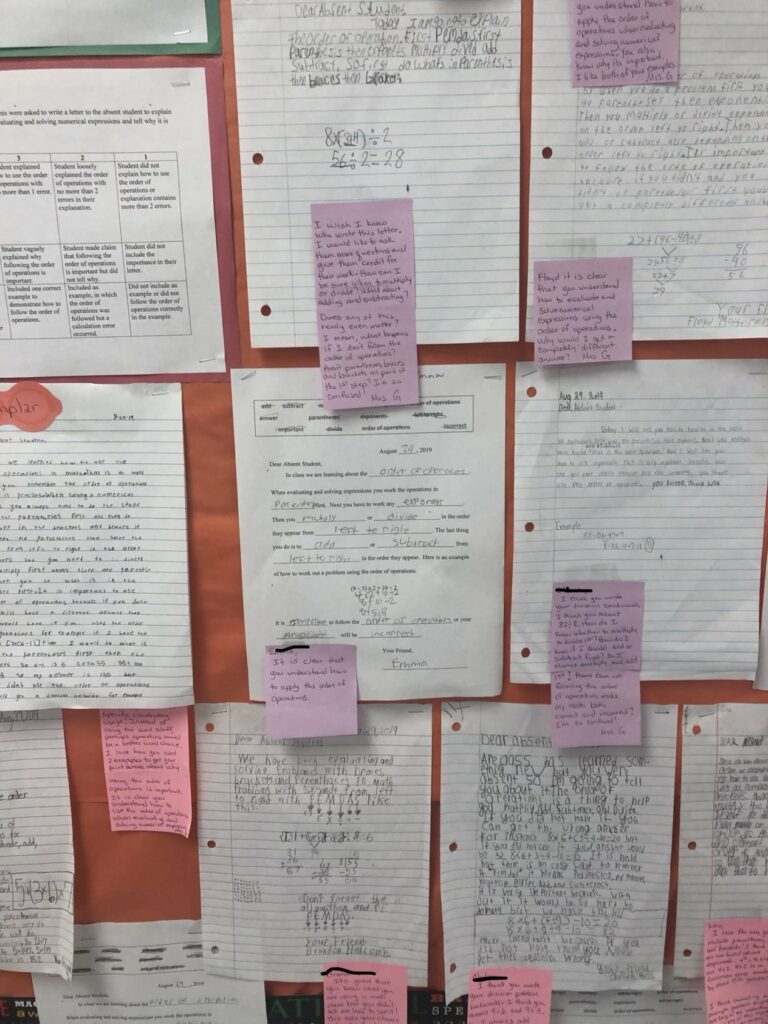Effective Writing Instruction: Focus on the Right Mindset
October 6, 2021 December 2, 2023
The topic of Mindset, either growth or fixed, is one of the most discussed topics in classrooms, PLCs, and meetings over the last few years. The phrase “I can’t yet” is synonymous with our goal to improve students’ outlook of themselves and their learning. Before we go any further, I believe that conversations on and about the Growth Mindset must continue. We must continue to look ahead at how we can use Growth Mindset to support learning for students and ourselves.
New Mindset Discussion
Along with a Growth Mindset, our internal and external conversations should also include discussions around the difference between an Infinite and Finite mindset. In Simon Sinek’s book, The Infinite Game, he introduces the idea of an Infinite Mindset versus the Finite Mindset. I encourage you to take the time to read the entire book. In the meantime, here is a quick explanation of the difference between these two mindsets.
- Finite Mindset is based on the idea of control and focusing on short-term wins over long-term gains. #WinNotWin
- Infinite Mindset is more difficult and focuses on long-term impact and may contribute to something that we may not see. #Win
What I found interesting is how clearly this connects to education and the actions we take in order to win the game of student learning.
Finite Mindset Example: Quick Review Before Asessing
As a science teacher, I would do a “quick review” just before I ask my students to take a quiz or test. This is an example of a Finite Mindset, I wanted my students to be successful on the quiz or test and wanted to give them one last chance to learn. This was a #WinNotWin situation because learning is not what I can remember for five minutes but is based on what I can remember and apply over an extended length of time.
Infinite Mindset Example: Assess to Adjust Instruction
To apply an Infinite Mindset to this situation means that I would skip the review, give them a test, and understand that the results would represent a more accurate picture of what students have learned. With an accurate picture, I would then be able to adjust my instruction to support the gaps or extend their learning for the future.
Applying Infinite Mindset to Teaching Writing
Writing! We have continuously shared effective writing instruction strategies and reasons why writing is important for student success. Discussing how to increase the number of writing opportunities for students often leads to a concern about the time it takes and the amount of curriculum that needs to be covered. Each of these concerns are valid, especially from the Finite Mindset.
However, if we are able to apply an Infinite Mindset to the problem we would be able to argue that why we may give up short-term wins the long-term impact would lead to more student success.
This is supported by countless research that demonstrates Writing improves learning by improving the transferring of information into long-term memory. For example, in a 2020 study, Constructing Written Arguments to Develop Fraction Knowledge, researchers found that students “with and at-risk for a learning disability in 4th, 5th, and 6th grades were taught two writing-to-learn strategies for constructing an argumentative paragraph” demonstrated an improvement in students’ fraction learning and with the quality of their mathematical reasoning.
“There are no silver bullets in education but writing – particularly nonfiction writing – is about as close as you can get to a single strategy that has significant and positive effects in nearly every other area of the curriculum. Nonfiction writing is the backbone of successful literacy and student achievement strategy.”
Douglas Reeves, American School Board Journal
One of the key reasons why writing is so impactful is the fact that it supports students’ deeper thinking on new learning. Writing forces students to corral their thoughts swirling around, develop clear ideas, and convert those ideas into the written language, and organize those into a narrative, argument, or explanation.
In essence, more effective writing instruction, and incorporating more writing in your classroom and across the school is leaning towards an Infinite Mindset — long-term learning. #Win



5 Tips to Incorporate More Effective Writing Instructional Strategies
As a principal, coach, or teacher you are part of your schools’ community. It is this membership that provides you the opportunity to lead with an Infinite Mindset, and increase writing opportunities. Here are some tips and ideas for discussion.
#1 – Take the Fear Out of Writing
One of the biggest obstacles students face is the fear of “doing it wrong.” In her article, “Minimizing Writer Apprehension in the Learner Centered Classroom.” LaVona Reeves talks about the reality of writing apprehension for students. She found that many students refused to write, “to save themselves from self-exposure, criticism, ridicule, and failure.” When asking students to write in your classroom make sure to always provide them with clear and explicit instructions on what you would like them to write about. Show them different examples and non-examples of the type of writing you want them to do. Let them know what parts of the writing will be assessed. If you are just looking for content to see where your students are in terms of their understanding of a concept, let them know.
#2 – Know and Understand Your Subject/Grade Level Writing Standards
It may sound like a “no-brainer,” however, it is imperative that you carefully read the writing standards for your grade level and plan to incorporate them into your content lessons. Including writing standards with content, standards will help you to infuse higher order thinking through the use of writing and help your students be successful on their assessments. Writing helps students conceptualize ideas. By having your students write, you will be helping them develop a deeper knowledge and understanding of content and communicate that knowledge. In this older article, If You Teach or Write 5-Paragraph Essays–Stop It! Ray Salazar shares some great ideas of how to “update” the traditional way of having your students write. It is a great conversation starter about how we are preparing our students to perform on writing assessments.
#3 Use Learning Journals
Learning Journals are a tool that you can implement K-12 with students in any subject area. Kindergarten students can write in learning journals through a combination of pictures, words and build-up to sentences. In the upper grades, consider having students write to justify the results of an experiment they have completed. Also, have students reflect on their own writing and writing processes. Here are some prompts to consider having students think about when writing learning logs:
What you write in this log should be what you want to keep/remember as a learner, reader, and writer. Written entries are your thoughts, reactions, interpretations, questions about what you are learning, reading, what you are writing, and what you are observing in the world around you.
- Quote or point out: Quote a part of the textbook, article, book, your own writing, or something you heard or read, that you think is an example of good writing. What did you like about the quote? What makes you feel this is good writing? Why do you want to save it?
- Experiences or memories: How does this text, concept, book, or article make you think or feel about the content? Does it remind you of anything? What comes to mind? What kinds of ideas do this topic, text, or article give you for writing?
- Reactions: Do you love/hate/can’t stop reading this topic? What makes you feel that way? What reactions do you have to your own writing, the writing, the writing of peers, and the world around you regarding this content, concept?
- Questions: What confuses you about this concept or content? What don’t you understand? Why did the author do something in a particular way? What would you have done if you were the writer? What questions do you have about your own writing? About observations of the world around you?
- Evaluation: How does this content, concept, article, and/or text compare to others you have read? What makes it an excellent, good, poor, or terrible piece of writing? How is your writing going?
#4 Use Graphic Organizers
Many times students have a hard time organizing their thoughts for their writing. If you are planning on having students write a longer piece, consider the way you would like to have students think and write about the topic and choose a graphic organizer that fits that type of thinking. For example, if you are going to have them write a compare and contrast piece on two characters, consider the Stick Figure Graphic organizer, in which students write character traits on two stick figures as they read/learn about the characters. This could also be used in social studies to compare historical figures, or in math with famous mathematicians.
#5 Let Them Practice and Share Their Writing
Providing multiple, short opportunities for students to write during a unit or lesson will deepen your students’ knowledge of the subject. Not every piece of writing students do in your class must be assessed, in fact, it shouldn’t. It should be used as a vehicle for thinking and processing information. Think, Ink, Share is a great way to infuse summary point writing during your lessons. You simply provide a prompt and give approximately 3-5 minutes for students to write, and then share their ideas. Not only are you having students summarize, but you are also “upping” the level of thinking in your lesson. Use Collaborative Pairs during writing. Allowing students to share their writing with a partner can ease the apprehension of sharing with the entire class as well as provide an opportunity to uncover and clarify any misconceptions they may have about the content.
Shifting to an Infinite Mindset is not easy and takes practice. The great news is that based on research and evidence that if you choose to transition any lesson to incorporate more writing you will have a long term learning impact on your students. #Win

Excellent article. I am so glad that my school places emphasis on writing. It is so important for the students. Thank you!